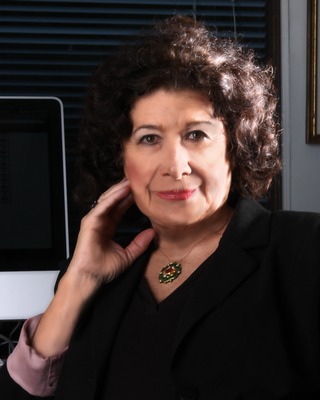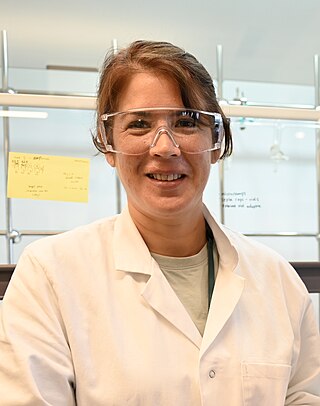Related Research Articles

The International Union of Pure and Applied Chemistry is an international federation of National Adhering Organizations working for the advancement of the chemical sciences, especially by developing nomenclature and terminology. It is a member of the International Science Council (ISC). IUPAC is registered in Zürich, Switzerland, and the administrative office, known as the "IUPAC Secretariat", is in Research Triangle Park, North Carolina, United States. IUPAC's executive director heads this administrative office, currently Greta Heydenrych.
Steven Victor Ley is Professor of Organic Chemistry in the Department of Chemistry at the University of Cambridge, and is a Fellow of Trinity College, Cambridge. He was President of the Royal Society of Chemistry (2000–2002) and was made a CBE in January 2002, in the process. In 2011, he was included by The Times in the list of the "100 most important people in British science".

Mary Lowe Good was an American inorganic chemist who worked academically, in industrial research and in government. Good contributed to the understanding of catalysts such as ruthenium which activate or speed up chemical reactions.

Nomenclature of Organic Chemistry, commonly referred to by chemists as the Blue Book, is a collection of recommendations on organic chemical nomenclature published at irregular intervals by the International Union of Pure and Applied Chemistry (IUPAC). A full edition was published in 1979, an abridged and updated version of which was published in 1993 as A Guide to IUPAC Nomenclature of Organic Compounds. Both of these are now out-of-print in their paper versions, but are available free of charge in electronic versions. After the release of a draft version for public comment in 2004 and the publication of several revised sections in the journal Pure and Applied Chemistry, a fully revised edition was published in print in 2013 and its online version is also available.
Angela K. Wilson is an American scientist and former (2022) President of the American Chemical Society. She currently serves as the John A. Hannah Distinguished Professor of Chemistry, associate dean for strategic initiatives in the College of Natural Sciences, and director of the MSU Center for Quantum Computing, Science, and Engineering (MSU-Q) at Michigan State University.
The International Union of Pure and Applied Chemistry (IUPAC) publishes many books which contain its complete list of definitions. The definitions are divided initially into seven IUPAC Colour Books: Gold, Green, Blue, Purple, Orange, White, and Red. There is also an eighth book, the "Silver Book".
Michelle Louise Coote FRSC FAA is an Australian polymer chemist. She has published extensively in the fields of polymer chemistry, radical chemistry and computational quantum chemistry. She is an Australian Research Council (ARC) Future Fellow, Fellow of the Royal Society of Chemistry (FRSC) and Fellow of the Australian Academy of Science (FAA).
Martina Heide Stenzel is a Professor in the Department of Chemistry at the University of New South Wales (UNSW). She is also a Royal Australian Chemical Institute (RACI) University Ambassador. She became editor for the Australian Journal of Chemistry in 2008 and has served as Scientific Editor and as of 2021, as Editorial Board Chair of RSC Materials Horizons.

Frances Separovic is an Australian biophysical chemist. She is a Distinguished Professor Emeritus of Chemistry at the University of Melbourne, where she taught physical chemistry and trained graduate students in her field. She is credited with developing techniques that utilise nuclear magnetic resonance spectroscopy (NMR) to study peptides in lipid bilayers, with applications in the study of the structure of membrane proteins and their effects on membranes. Her more recent research concerns 'the structure and interactions of amyloid peptides from Alzheimer's disease, pore-forming toxins and antibiotic peptides in model biological membranes'.
Traian V. Chirilă is a Romanian-Australian polymer and organic chemist who is the inventor of AlphaCor, an artificial cornea in current clinical use throughout the world.
Margaret Harding is an Australian chemist and educator who is currently Deputy Vice-Chancellor (Research) at The Australian National University (ANU). She is an expert in medicinal and biomolecular chemistry, with special research interests in the areas of antifreeze proteins and ligand-DNA interactions.

Zafra M. Lerman is an American chemist, educator, and humanitarian. She is the President of the Malta Conferences Foundation, which aims to promote peace by bringing together scientists from otherwise hostile countries to discuss science and foster international scientific and technical collaboration. From 1986 to 2010, she chaired the American Chemical Society's Subcommittee on Scientific Freedom and Human Rights. She has been successful in preventing executions, releasing prisoners of conscience from jail and bringing dissidents to freedom. She is the recipient of many awards for education and science diplomacy, including the 1999 Presidential Award from U.S. President Clinton, the 2005 Nyholm Prize for Education from the Royal Society of Chemistry (England), the 2015 Science Diplomacy Award from the American Association for the Advancement of Science (AAAS), the 2016 Andrei Sakharov Award for human rights from the American Physical Society (APS), the 2016 United Nations NOVUS Award for the 16th Sustainable Development Goal: Peace and Justice, and the 2017 International Union of Pure and Applied Chemistry Distinguished Women in Chemistry or Chemical Engineering Award.
Véronique Gouverneur is the Waynflete Professor of Chemistry at Magdalen College at the University of Oxford in the United Kingdom. Prior to the Waynflete professorship, she held a tutorial fellowship at Merton College, Oxford. Her research on fluorine chemistry has received many professional and scholarly awards.

Margaret Mary Sheil is an Australian academic and the Vice Chancellor of Queensland University of Technology.
Ingrid del Carmen Montes González, is a Puerto Rican chemist who is a professor in at the University of Puerto Rico, Río Piedras Campus. Her research focus is on chemical education and organometallic chemistry. Montes has been Director-at-large at the American Chemical Society (ACS) since 2013. Montes founded the "Festival de Química" in 2005, this program was then adopted by the ACS in 2010.

Natalie Stingelin, Fellow of the Materials Research Society and Royal Society of Chemistry, is a materials scientist and current chair of the School of Materials Science and Engineering at the Georgia Institute of Technology, the University of Bordeaux and Imperial College. She led the European Commission Marie Curie INFORM network and is Editor-in-Chief of the Journal of Materials Chemistry C and Materials Advances.

Vanderlan da Silva Bolzani is a Brazilian chemist at the São Paulo State University. She has previously served as president of the Brazilian Chemical Society and was awarded the 2011 American Chemical Society – International Union of Pure and Applied Chemistry Distinguished Women in Science Chemistry and Chemical Engineering Award.
Jonathan Baell is trained as an Australian medicinal chemist and is currently executive director, early leads chemistry at Lyterian Therapeutics in San Francisco. Prior to this, he was a research professor in medicinal chemistry at the Monash Institute of Pharmaceutical Sciences (MIPS), the director of the Australian Translational Medicinal Chemistry Facility and a Chief Investigator at the ARC Centre for Fragment-Based Design. He was President of the International Chemical Biology Society 2018-2021 and is currently chair of the board. His research focuses on the early stages of drug discovery, including high-throughput screening (HTS) library design, hit-to-lead and lead optimization for the treatment of a variety of diseases, such as malaria and neglected diseases.

Deanna Michelle D'Alessandro is an Australian chemist who is a Professor and Australian Research Council Future Fellow at the University of Sydney. Her research considers fundamental aspects of electron transfer in molecular coordination complexes and in nanoporous materials, and the development of metal–organic frameworks for environmental applications including carbon dioxide capture and conversion.

Christine Luscombe is a Japanese-British chemist who is a professor at the Okinawa Institute of Science and Technology. Her research investigates polymer chemistry, organic electronics, organic photovoltaics and the synthesis of novel materials for processable electronics. She serves on the editorial boards of Macromolecules, Advanced Functional Materials, the Annual Review of Materials Research and ACS Applied Materials & Interfaces.
References
- 1 2 3 4 5 6 7 "Under the microscope: Professor Mary Garson (NC 1971)". Newnham in Australia: Newsletter. September 2010. 2010.
- ↑ "Professor Mary Garson CChem FRSC | 175 Faces of Chemistry". www.rsc.org. Archived from the original on 27 March 2019.
- ↑ "Professor Mary Garson | School of Chemistry & Molecular Biosciences". staff.scmb.uq.edu.au. Retrieved 9 June 2017.
- 1 2 3 Centre, The University of Melbourne eScholarship Research. "Garson, Mary – Biographical entry – Encyclopedia of Australian Science". www.eoas.info. Retrieved 23 March 2017.
- 1 2 3 "Mary J. Garson" (PDF). Retrieved 23 March 2017.
- ↑ Stewart, Doug (1 July 1999). "Sponges get respect". International Wildlife. 29 (4): 27 – via Factiva.
- ↑ "University team wins women's award" . Retrieved 23 March 2017.
- ↑ "2011 Award Winners – The Royal Australian Chemical Institute Incorporated". www.raci.org.au. Retrieved 23 March 2017.
- ↑ "Professor Mary Jean Garson". honours.pmc.gov.au. Retrieved 26 January 2019.
- ↑ "Academy announces 2024 Fellows for outstanding contributions to science". Australian Academy of Science. Retrieved 22 May 2024.
- ↑ "Cambridge innovators to inspire future Nobels, Curies and Faradays | Business Weekly | Technology News | Business news | Cambridge and the East of England". www.businessweekly.co.uk. Retrieved 23 March 2017.
- ↑ "Chemistry International – Newsmagazine for IUPAC". www.iupac.org. Retrieved 23 March 2017.
- ↑ Garson, Mary (24 January 2011). "Women are good for chemistry". Courer Mail.